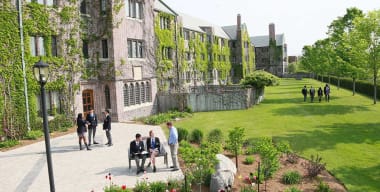In practice, however, it’s much more than that. The best STEM programs are ones that not only stress the academic areas, but do so in an interdisciplinary way; they are programs where the sciences aren’t siloed—learning math in one classroom and chemistry in another—but integrated so that students not only perceive the connections between them, but also apprehend their mutual application.
STEM programs achieve that, largely, through problem-based learning, with each of the elements providing tools for discovery, creative problem solving, and communication:
- Science: questioning, observing, predicting
- Technology: applying analytic tools, putting ideas into practice, being inventive
- Engineering: building, understanding material properties, designing effective solutions
- Math: identifying patterns, making connections, communicating results
That’s what distinguishes STEM programs from the science classes that we knew when we were in grade school and high school. Physics, for example, was the class that we took, and little if any effort was made to relate it to the other science disciplines or, all too often, practical application. STEM programs, in contrast, are curiosity-driven, applied to real-world problems, ranging across disciplines, and conducted in collaboration with others. Physics isn't so much a thing unto itself, but rather a set of ideas, principles, and tools that can be used to help answer questions and solve problems. Yes, there are still bricks and inclined planes, but they're a starting point, rather than an endpoint of study.
STEM in schools
In some ways, the goal of STEM programs is to get beyond the prejudices that we might have about the sciences, including, say, the difficulty of physics or the nerdiness of computer coding. Those things are less in evidence today than they once were, but STEM programs take that even further and work to make the sciences inviting, approachable, and inspiring.
If there is a dark side to STEM, it’s the awareness that women continue to be underrepresented in industry, something that can be a catalyst for the adoption of a STEM approach. “Now more than ever it’s important to see strong female leadership in the tech industry,” says Reshma Saujani, CEO & Founder of Girls Who Code, one of the most visible STEM programs out there today. She’s right of course, and in all kinds of ways. Girls want to be involved in tech, but often there remain hurdles to involvement. That’s coupled with an awareness that industry benefits from a proliferation of voices, perspectives, and approaches. It’s about parity in the workplace, as well as making sure that talent is encouraged and applied to the best advantage for all.
The introduction of STEM-specific programming is a bit of a rising tide in the private school market across the country. St. Margaret’s School in Victoria, BC, was an early adopter, the country’s first girl’s school to have a fully-fledged STEM program. There, and elsewhere, the adoption of STEM is aligned with gender parity. In 2016 the Coalition of Single Sex Schools of Toronto (COSSOT) devoted its annual conference to the intersection of gender and the sciences, and was titled STEMinism (a neologism of STEM and feminism). Keynote speakers included Dr. Shohini Ghose, director of physics and computer science at Wilfrid Laurier University, and Dr. Renee Hlozek, professor of astrophysics at the University of Toronto.
The association of STEM and gender is absolutely valuable, and the benefits are readily apparent. That said, it’s important to note that, at its core, STEM isn’t about gender specifically but rather about how schools approach the delivery of science and technology curricula. It’s about how we frame questions, as well as growing awareness of the how questions are best asked and the tools available for answering them.
A new relationship to science
STEM programs seek to reorient students’ relationship to science, namely through working collaboratively. Especially in the past, scientists were thought of as lone geniuses. Einstein, for example, devising the theory of relativity while riding a bicycle through the countryside, Newton sitting beneath a tree, Pythagoras cogitating in his cave, or Darwin scribbling away in his berth on the Beagle.
There is some truth to those ideas, and in the past many people did actually work in isolation. Einstein very famously did. So did Gregor Mendel and Marie Curie. Many, however, didn’t, and Thomas Edison is a great example of that. The oft-repeated idea that he invented the lightbulb, for example, reflects a desire to see inspiration and lone genius at the core of scientific discovery and technological advancement. But Edison would better be celebrated as one of the first in the world of technology who saw what the tech fields would in time become, i.e., collaborative. Menlo Park was perhaps his greatest invention, a facility bringing hundreds of people together, along with their talents, and applying them to solving real-world problems. For the light bulb Edison built a team of people to help find the right filament, and they experimented with hundreds of materials, from carbonized banana peels and beard hair, to, ultimately, tungsten. (Robert Friedel and Paul Israel in their book Edison's Electric Light: A Biography of an Invention note 22 inventors who created incandescent lamps prior to Edison—he wasn’t the inventor so much as the director of the lab that was first to produce a commercially viable prototype.)
STEM programs adopt and promote that idea, namely that science and technology isn’t a field dominated by lone geniuses squirreled away ruminating on problems. Rather, it’s a celebration of the community of people around the world that, working together, will solve the problems that we face and, together, make the greatest advances.
STEAM and other variations
In the acronym STEAM, the 'a' stands for arts. The integration of arts is quite often the integration of design principles, though it can also extend to the fine arts, and arts management. STEAM camps, thus, might claim to offer richer programming.
Still others create variations that are more inclusive. Some variant acronyms that are used, each denoting a slightly revised take on the STEM concept include:
- STREM: Science, Technology, Robotics, Engineering and Mathematics, adding robotics as a field.
- GEMS: Girls in Engineering, Math, and Science. For learning programs that encourage young women in science and technical fields.
- BEMS: Boys in Engineering, Math, and Science. Used for programs that encourage young men.
- STEMM: Science, technology, engineering, mathematics, and medicine.
- AMSEE: Applied math, science, engineering, and entrepreneurship

STEM camps and programs
Recent years have likewise seen a burst of interest in STEM and camps that offer an extensive curriculum in science, technology, engineering and mathematics. Camps across Canada are responding to the growing demand for STEM activities. These four areas of learning are focused on, as they are critical to individual development and preparation for a world increasingly dominated by technology.
Camps with STEM-focused curriculum make learning fun and enjoyable for kids. STEM is increasingly relevant in education policy, and is implicated in curriculum choices, as schools prepare students for a changing workforce.
There are many kinds of educational camps of course. There are advantages offered by camps that offer more precise specialization, such as you might get if you attend one of your local robotics camps or programming camps. The advantage of a STEM camp for your budding learner is integration of these disciplines. If your child is very focused on mathematics, for example, he or she may only be interested in math camps. The same goes for children (and parents) seeking out science camps, technology camps or engineering camps.

STEM camps and programs are opportunities for children to get involved in the sciences, in a group of peers, either to indulge a passion or to broaden their horizons. Camps allow children to meet other kids outside of their school and neighbourhood friends, kids in the same city with a mutual interest in these disciplines. Camp helps them see the fun in related pursuits and may help them expand their comfort zone. STEM camps explore academics in unique ways that are less structured and formal than what they find in a school environment. By cultivating your child's interest in STEM, you are better preparing them for high school and higher learning.
Educational camps offer an increasingly broad curriculum, to meet the changing demands of parents. Precise specialization is valuable, also, as seen in a robotics camp, coding camp or an engineering camp. However, STEM camps are an important means of integrating learning in various areas and broadening learning.
Curriculum in a STEM camp tends to be more advanced and—given that children in the camp are likely to be advanced learners—can more freely apply sophisticated learning and even vocabulary that may not be available in some typical school settings.
Camp curriculum will often be taught by guest experts and professionals in the field (including university professors, for example) who may have more time or freedom in the summer to get out and meet younger enthusiasts. The focus on (and love of) learning in these camps spreads from camp counselors, instructors and guests to the students. The best STEM camps create an impromptu community of lovers of learning, especially in these four disciplines.
Camps are a great way to extend STEM learning in unique ways.
- Camps encourage kids to interact with a new, unique peer group and open up new friendships. In a STEM camp, kids meet other kids in their community with shared interests in the practical pursuits of science, technology, engineering and mathematics.
- Kids with advanced learning skills find more stimulation in a STEM camp, where the activities may be more intellectually challenging and thought-provoking.
- Many STEM camps feature interesting guest experts who may open up future opportunities for children with academic strength in these areas.
- The love of learning created in a STEM camp is infectious, and will encourage your child to grow in new directions.
•











